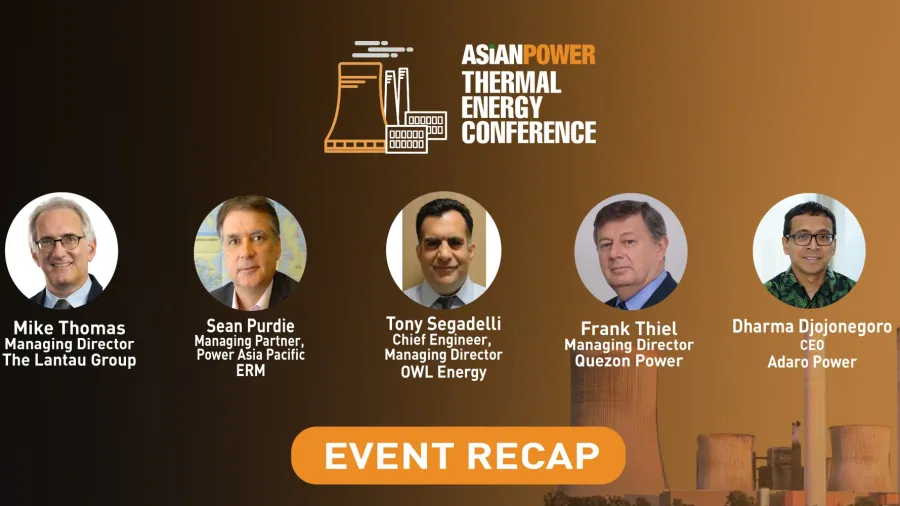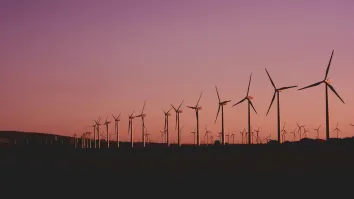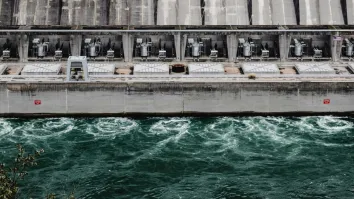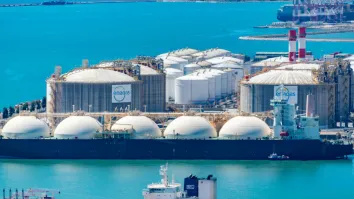
Bidding thermal power goodbye? It will be a long journey
Asia’s 1.5TW coal-fired capacity is still at a ‘youthful state’, The Lantau Group’s Mike Thomas says.
Whilst emerging technologies are in place to support the energy transition, experts from various Asian countries argue that veering away from thermal energy, like coal, in Asia will take at least 20 more years as there is a need to ensure energy security.
In Asia, China has the largest coal capacity at 1,050 gigawatts (GW), followed by India at 198.6GW. Overall, the region’s coal-fired capacity is currently at 1.5 terawatts, with most of its power plants at 15 years old and less.
“I think given the youthful state of thermal capacity in Asia, If you think about the long goodbye, we're still talking about 20 years, [maybe around] 2040s,” Mike Thomas, managing director of The Lantau Group, said at the Asian Power Thermal Energy Conference.
“Thermal capacity is essential to energy security, competitiveness of industry, and affordability of tariffs. If you want to speed that transition up, then it will cost more money. That's just a decision that needs to be taken,” he said, adding that most of the coal capacity is new, efficient, and super or ultra-supercritical design.
Asian countries’ energy status
In China, Thomas said coal capacity runs at an average utilisation of 50% and when there is more demand and there are fewer renewable energy sources such as hydro generation, coal will take over.
“Usually, it's some other [energy source], like gas, or peaking capacity in other parts of the world. But in China, it's coal. So again, this fits the whole energy security call, viable supply chain, and financial sustainability. Everything has to fit together. You can have an energy transition, but everything has to be orderly along the way,” he said.
China has recently undergone a power crisis wherein power rationing measures were imposed in 20 provinces from late September 2020. The reasons for the rationing vary per province but include strong power demand growth due to high industrial consumption and unseasonal weather.
There was also insufficient domestic coal production which resulted in high coal fuel prices, leading to coal-fired generators being unwilling to operate their plants. There were also provincial restrictions and energy consumption and intensity to meet environmental goals, as well as poor generation from hydropower and other generation such as wind.
Thomas noted coal is going to be sold in open markets where commercial and industrial power users are going to buy them.
Thailand, meanwhile, is not a ‘coal country,’ mostly reliant on gas and growing renewables. Its commercial and industrial solar capacity grew 22% to its peak of 976 megawatts (MW). But Thomas said its limited coal remains and will only be out of its generation mix when it reaches the end of technical life or the policy turns “antagonistic.”
Thomas also said that Vietnam’s peak electricity demand is expected to register a compound annual growth rate of 7.8% between 2025 and 2030. There is a significant increase in renewable energy, but there is still the building of some coal and gas.
“It's very difficult because of the rate of growth to nudge conventional [power] out in Vietnam. The coal is actually mostly less than 10 years old, and quite a bit of this is just a little bit more than five. So we are talking about fairly efficient and very new coal plants,” he said.
Malaysia, meanwhile, has pledged not to build new coal plants and there will be some coal retirements around 2030, he said. However, the existing coal base will only go down when the power purchase agreements expire.
Thomas noted that there may be an opportunity for existing coal to come back if there is a wholesale market or the plants can be phased out when the deals expire. It also depends on the emerging carbon policy.
“But from a lifetime point of view, most of the coal will continue to operate in Malaysia through the end of the 2030s and into the early 2040s,” he said, adding that one of the reasons for this is that gas has been the marginal fuel. Thomas also said that the entry of solar energy can displace gas, whilst integration of more renewable energy can address coal.
Coal also remains to be an important part of Indonesia’s energy mix, said Adaro Power CEO Dharma Djojonegoro.
“I think Indonesia, at some point, has to come to a choice. whether we want to keep our very competitive electricity costs and therefore, still stick with coal, or no, we forgo this and we go to the other renewable energies? And I think we haven't gotten to the timing of that choice yet,” he said.
In the Philippines, Frank Thiel, managing director of coal plant Quezon Power, said the Department of Energy, particularly Secretary Alfonso Cusi, recognises that coal and thermal power has to remain in the energy mix, with coal comprising 52% of the country’s energy mix.
Thiel said that there is a moratorium against the building of new coal plants in the country but the around 3,500MW in the pipeline may proceed.
Quezon Power has an existing power supply purchase agreement with Manila Electric Co., the power distributor in the capital region, that will expire in May 2025. Thiel said they will work on securing another PSA that will run for 20 years.
If the bid will not be successful, Quezon Power will look for other alternatives, such as selling power to retail energy suppliers, or it will operate within the wholesale electricity market in the Philippines.
‘Final resting point’
One way for thermal units to find their “final resting point” is through incursion, Thomas said. He cited as an example the battery storage which “could cannibalise the higher value evening period.” This could result in rising operation costs, reduced efficiency, and increased maintenance.
Another way is by displacing thermal units during off-peak by other energy sources such as wind or excess capacity, amongst others.
Thomas said that these two ways can occur at the same time which can result in investment risk review of the plant or its value being weakened by other factors, leading to the retirement of the coal plant rather than the reinvestment.
Timing is also another crucial part of the shift away from thermal units as several factors have to be considered before taking action such as policy settings, capacity, cost, and alternatives, he said, noting, however, that this equation takes a long time to pay out in Asia.
Thomas also said that there has to be a “framework for structured exits” for the energy transition, as there are “lumpy power stations coming in or going out in the market all at once.”
He cited EnergyAustralia Holdings Limited which entered into an agreement with the State Government of Victoria, Australia for the orderly retirement of Yallourn coal-fired power in 2028, four years before the end of its technical life.
Under the agreement, EnergyAustralia committed to build by 2026 a new utility-scale battery of 350MW capacity in Victoria and it will provide a “comprehensive workforce transition package.”
“We have markets that are supposed to meet capacity targets and develop energy efficiently. But we don't really have frameworks for the energy transition where we're actually trying to transform by way of exit and entry simultaneously,” he said.
Alternatives, emerging technologies
Thomas said the most “commercially attractive standalone opportunities” are the displacement of liquified natural gas (LNG) costs.
LNG-based energy is often the next best option as it is “both highly variable and generally more expensive than the most efficient coal plants would have been.
He also noted that a lot will depend on fuel prices because, if coal, gas, and other fossil fuels are more expensive, then this will accelerate the increase in renewable energy on a “commercial and policy level.”
Green hydrogen is also a technology that has a good opportunity for growth as there have been a lot of wind farms that have been built, according to Owl Energy Managing Director Tony Segadelli.
“In the UK, for example, there's excess wind power during some times of the year, there's an opportunity to build large solar in desert areas, which can be used for taking hydrogen out of the air, you can mine hydrogen,” Segadelli said, comparing it to carbon capture storage (CCS).
Quezon Power’s Thiel also noted that CCS continues to be a developing technology as it is expensive. He said that to capture carbon from a 100MW plant, there is a need to put in an additional plant to provide power for the technology.
Meanwhile, Djojonegoro also noted that the transition to clean energy and phasing out coal in Indonesia can be solved by existing technology but the cost is “prohibitive.” He also noted that hydropower is in remote places, whilst geothermal is small and expensive.
Rooftop solar is also emerging in some markets like Thailand where the price is high but Indonesia has not embraced it yet, according to Segadelli.
“If you go into say Java, Bali, the grid price is so low, that is no real incentive to build huge amounts of rooftop solar,” he said.
Climate change impact
Climate change would also have an impact on project developments, particularly on the power sector, Sean Purdie, CEO of ERM, said.
Purdie noted that greenhouse gases have increased and among its effects include a glacial retreat and the warmer climate also lead to sea level rising. He noted that physical climate changes increased in “frequency and intensity with every marginal increase in global warming.”
Climate changes will result in frequency and increase in the intensity of heavy one-day precipitation over land as well as agricultural and ecological droughts in the drying region, he said, noting that this is dependent on the rate of temperature changes.
“These will increasingly mean demands on water. Difficulty or increased difficulties in being able to finance projects if you're unable to prove the availability of water supply or confirm that you will be able to access water backed up by scientific confirmation of the predictions for the availability of water for example, across the life of the project, 20 years 25 years, etc,” he said.
Future trends in the climate include temperatures reaching over 1.5 Celsius higher by 2040, from 1800 levels, under all emission scenarios. There may be no summer sea ice in the Arctic, at least once by 2050, fire weather will be more likely in many regions, changing monsoons, and more precipitation for higher altitudes and less for higher altitudes.
“More drought, less water, more difficulty to ensure water supply for cooling systems for example and thermal power plants. Higher temperatures mean lower ambient to operating temperature deltas so more cooling is required, [hence] more power required to keep the system operating,” he said.
In East Asia, Purdie noted that precipitation extremes have increased in parts of the region and will increase in frequency and intensity, which leads to more frequent landslides.
Droughts have become more frequent in continental East Asia, whilst Eastern Central Asia has become wetter. He also noted that the rate and increase in the intensity of strong tropical cyclones have risen. Tropical cyclone tracks are also likely going to traverse northward.
In Southeast Asia, future warming will be slightly less than the global average, whilst rainfall will increase in northern parts and decrease in western Pacific areas. The region also experiences fewer but more extreme tropical cyclones.
“This means greater analysis and emphasis and understanding of maximum wind speeds which will affect the design parameters, the essential the right design parameters of any infrastructure project, including all types of power stations,” he said.



















 Advertise
Advertise







